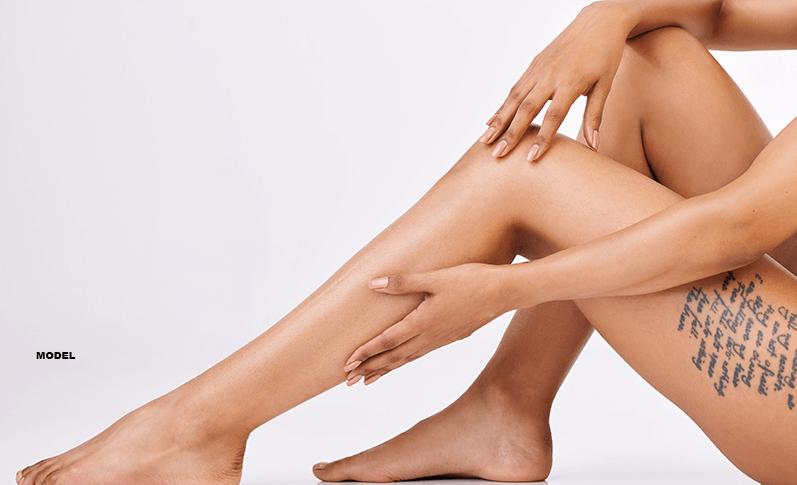Can You Get Laser Hair Removal Over A Tattoo?

Laser hair removal has become a popular choice for those looking to rid themselves of unwanted hair safely and permanently. This innovative technology offers a convenient solution to the hassle of constant shaving or waxing and can be performed on various body areas such as the legs, armpits, chest, arms, and bikini area.
One common question perspective patients ask is “can laser hair be used to treat tattooed skin?” In this blog post, we will explore the possibilities and limitations of getting laser hair removal over a tattoo.
How Laser Hair Removal Works
Before delving into the specifics of laser hair removal on tattooed skin, here is a brief overview of how the procedure works. Laser hair removal operates on the principle of targeting the pigment in hair follicles, known as melanin. The laser emits a concentrated beam of light that is absorbed by the melanin, which in turn generates heat, ultimately disabling the hair follicle and preventing future hair growth.
Targeting melanin
The laser emits a concentrated beam of light, which is absorbed by the pigment called melanin in the hair follicles. Melanin is the substance responsible for the color of the patient’s hair and skin. The laser is designed to specifically target melanin without significantly affecting the surrounding skin.
Selectively heating the follicles
When the laser energy is absorbed by the melanin in the hair follicles, it transforms into heat. This heat remains in the follicle, causing damage that prevents the hair follicle’s ability to grow new hair. The surrounding skin remains relatively cool and unaffected, thanks to the laser’s precision.
Laser Hair Removal is Not Compatible With Tattoos
Laser hair removal is a safe and effective way to eliminate unwanted hair on nearly any area of the body. However, laser hair removal cannot be used to remove hair on tattoos (or tattooed skin to be more specific). The primary reason for this incompatibility lies in the way the laser targets pigmentation. Tattoos consist of ink pigments embedded in the skin, and laser hair removal machines are designed to focus on the melanin within hair follicles. If a hair removal laser was to be pointed at tattooed skin, it would perceive the entire tattoo as a target for energy delivery. Rather than delivering a tiny zap of heat energy to a single follicle, the hair removal laser would over deliver heat energy to the entire tattooed skin surface.
This issue is like issues faced by individuals with darker skin tones who wish to undergo laser hair removal. Today’s lasers can safely treat Fitzpatrick skin types V & VI, but they are still unable to safely address tattooed skin.
What Issues Could Happen
Performing laser hair removal over a tattooed area can lead to several undesirable consequences, including:
Burns: The laser may cause burns on the tattooed skin, as it is not designed to differentiate between hair and tattoo pigment.
Moderate to Severe Skin Damage: The intense energy directed at the tattoo can result in damage to the skin, potentially causing scarring or discoloration.
Pain: Patients may experience significant discomfort or pain during the procedure.
Negatively Altering the Appearance of the Tattoo: The tattoo’s appearance may be adversely affected, with fading, distortion, or other aesthetic changes.
Laser Hair Removal is Different Than Laser Tattoo Removal
You might be wondering why laser technology cannot be used to remove both hair and tattoos at the same time. The reason comes down to key differences in how each laser works. Hair removal lasers are designed to deliver energy specifically for hair follicle destruction. In contrast, tattoo removal involves the use of Q-switched lasers that emit energy at a much faster rate, causing tattoo pigment to fragment and dissipate. These are very distinct technologies with very different applications.
Laser Hair Removal is Possible in Tattooed Areas (Just Not The Tattoo Itself)
While laser hair removal directly over a tattoo is not advisable, it is still possible to target hair in the surrounding areas. A skilled technician can carefully cover the tattooed portion while treating the adjacent skin, allowing hair removal in those regions. However, it is essential to note that hair will continue to grow on the tattooed skin, and patients may need to consider other hair removal options like shaving or waxing for that specific area.
Consider Tattoo Removal First
If laser hair removal remains a priority for individuals with tattoos, the best course of action is to first undergo laser tattoo removal. Once the tattoo is completely removed, laser hair removal can then be safely performed in the area without any risk of pigment interference.
While laser hair removal is a fantastic solution for permanent hair reduction, it should be avoided directly over tattooed areas due to the potential risks and complications involved. If the patient is determined to enjoy the benefits of both laser hair removal and their tattoos, consider getting the tattoo removed first to ensure a safe and effective hair removal process.
Always consult with a qualified practitioner to discuss the patient’s unique circumstances and options for achieving the desired results. Laser hair removal should be performed by trained and licensed professionals to ensure safety and effectiveness. The choice of laser equipment and settings should be tailored to an individual’s skin type and hair color to minimize the risk of side effects, such as burns or skin discoloration.
